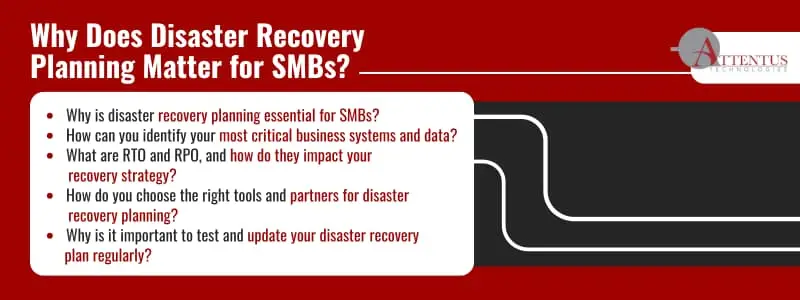The wrong disaster recovery planning leaves your business exposed to costly downtime. The right plan protects operations, data, and your bottom line.

Did you know that nearly 60% of small businesses fail within six months of a major data loss event?
When a power failure, cyberattack, or system crash occurs, recovering operations may take several days, weeks, or may never fully happen. Even a few hours of downtime can result in lost revenue, damaged customer trust, and long-term reputational harm.
That means having an effective disaster recovery plan is not an optional I.T. expense. It’s a critical business strategy that gives business owners the structure and tools to recover quickly and avoid preventable financial harm.
Here’s a step-by-step breakdown of how to create an efficient disaster recovery plan.
Identify critical systems and data
Building a solid foundation starts with identifying which parts of your business simply can’t afford to go offline. Ask yourself:
- Which software, files, or databases do we rely on daily?
- Which business functions (billing, payroll, communications) must continue at all costs?
- Which customer-facing tools need to remain accessible?
These essential functions make up your core continuity layer and should be protected and prioritized during recovery. The right I.T. team can guide you through this process, helping to safeguard your data and audit your systems to identify what is truly mission-critical and what can be temporarily deprioritized. This ensures your plan stays focused on what matters most without becoming overly complex or over-engineered.
Assess the risks
After identifying which systems must remain in place at all costs, evaluate potential digital or physical threats. A strong disaster recovery plan must account for:
- Natural disasters (floods, wildfires, earthquakes)
- Cybersecurity breaches (ransomware, phishing attacks)
- Human error (accidental deletion, misconfigured systems)
- Power or internet outages
- Hardware failures or system crashes
Rank each by likelihood and potential impact so you make sure you allocate resources where they’re needed most. Many SMBs underestimate cyber threats until they’re targeted, for example, but even the smallest businesses are vulnerable and often easier to exploit.
Define RTO and RPO
These two metrics are the backbone of any disaster recovery planning strategy:
- RTO, or recovery time objective, is the time it takes for a system or function to be restored after a disruption.
- RPO, or recovery point objective, is the amount of data you can afford to lose, measured in terms of time.
If you set an RTO of four hours, for example, you know your systems must be back up within that window. If your RPO is one hour, you can only afford to lose up to one hour of data. The tighter your objectives, the more robust (and sometimes costly) your plan must be.
That’s why balancing technical needs with business priorities is key, and where experienced managed service providers (MSPs) can help create realistic, cost-effective targets.
Build a backup strategy using the 3-2-1 rule
Effective recovery requires reliable backups, which can be achieved through the industry-standard 3-2-1 backup rule: Keep three copies of your data, store them on two different types of media, and ensure one copy is offsite (ideally in the cloud).
Backups should be automated, encrypted, and regularly tested to ensure their effectiveness and reliability. Don’t rely on manual systems or assume your data is safe because it “hasn’t failed yet.”
Choose the right tools and partners
You don’t need to buy enterprise-grade disaster recovery software to protect your business. But you do need tools and support that scale with your needs.
Affordable options for SMBs include:
- Cloud-based backup solutions
- Disaster recovery as a service (DRaaS) providers
- Managed I.T. service providers that offer end-to-end planning, implementation, and support
When selecting tools or partners, ask whether they offer flexible packages for SMB budgets, can align I.T. recovery plans with your business goals, and if they will take ownership, not just react when things go wrong. Proactivity is your strongest defense.
Create a clear communication plan
A well-documented disaster recovery plan is useless if no one knows how to execute it. Every plan should include:
- Who leads the recovery process
- How staff are notified during a crisis
- Which systems or steps is each person responsible for
- Emergency contact lists and vendor information
Ensure this information is available in multiple formats and accessible during an outage, not just stored in the cloud. You must also train your team not to panic should a real disruption happen.
Test it, then test again
One of the most overlooked parts of disaster recovery planning is testing. A plan that only exists on paper is unproven, so you need to schedule regular drills and simulations to ensure your plan works. This includes:
- Confirming your RTO/RPO targets are achievable
- Identifying weak links in your systems or processes
- Training your staff under realistic conditions
Each test provides insight, improves resilience, and makes your actual response smoother. Your disaster recovery plan should also be updated after every significant business change, such as adding a new location, vendor, or software update.
Document everything
All your planning is only helpful if it’s documented and accessible. Your disaster recovery plan should include:
- An executive summary
- Risk analysis and critical systems inventory
- RTO/RPO targets
- Backup schedules and storage locations
- Team roles and emergency contacts
- Testing protocols and results
- A revision log
This ensures nothing gets missed or overlooked.
Formulate a formidable disaster recovery plan with Attentus
Waiting for a disaster to strike before starting to plan is risky. Building a proactive disaster recovery strategy protects your operations, minimizes financial loss, and helps your team act with confidence when challenges arise.
For SMBs, this doesn’t mean spending like an enterprise. It means getting expert help, smart tools, and a strategy built around your actual risks and goals. That is where Attentus Technologies comes in handy.
We partner with Pacific Northwest businesses to make disaster recovery practical, affordable, and effective. Guided by our core value of “seeking constant improvement,” we continuously refine strategies to keep pace with evolving threats and technologies. Our focus is on long-term resilience, not short-term fixes, because we know expert I.T. means your team rarely needs to call the help desk in the first place.
Contact us today to discuss creating a customized disaster recovery plan tailored to your business, budget, and growth objectives.
